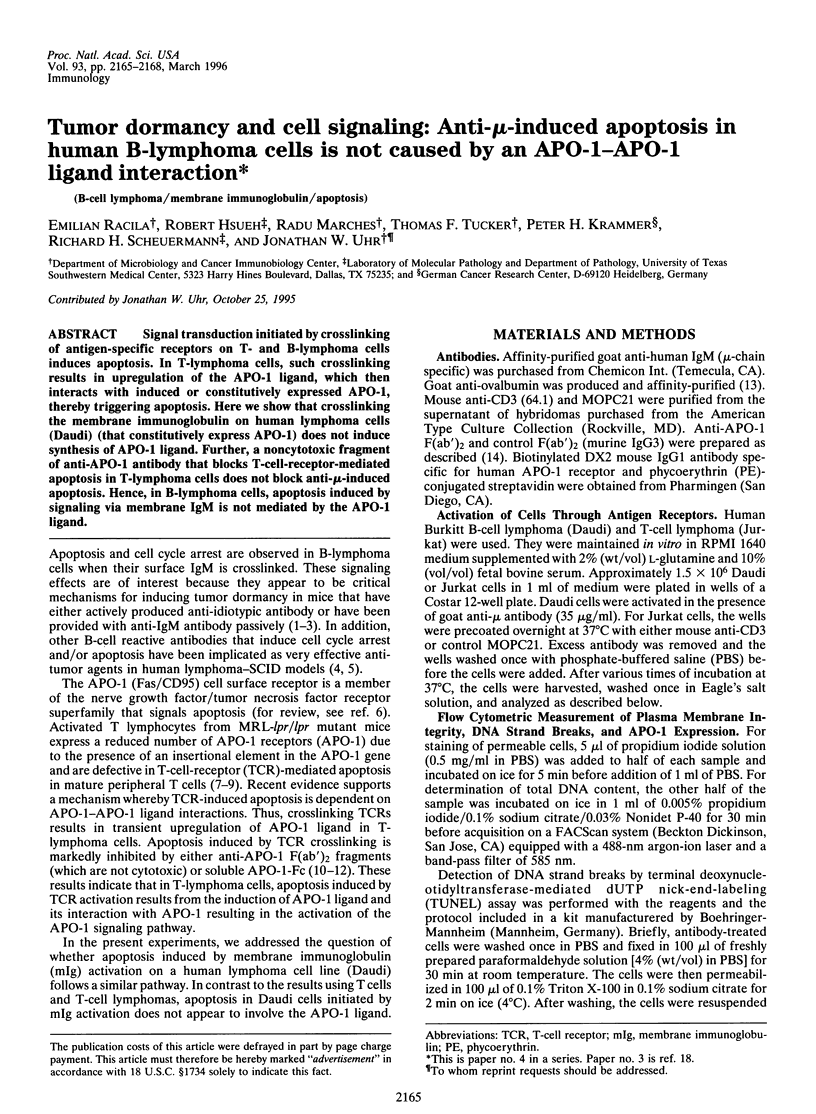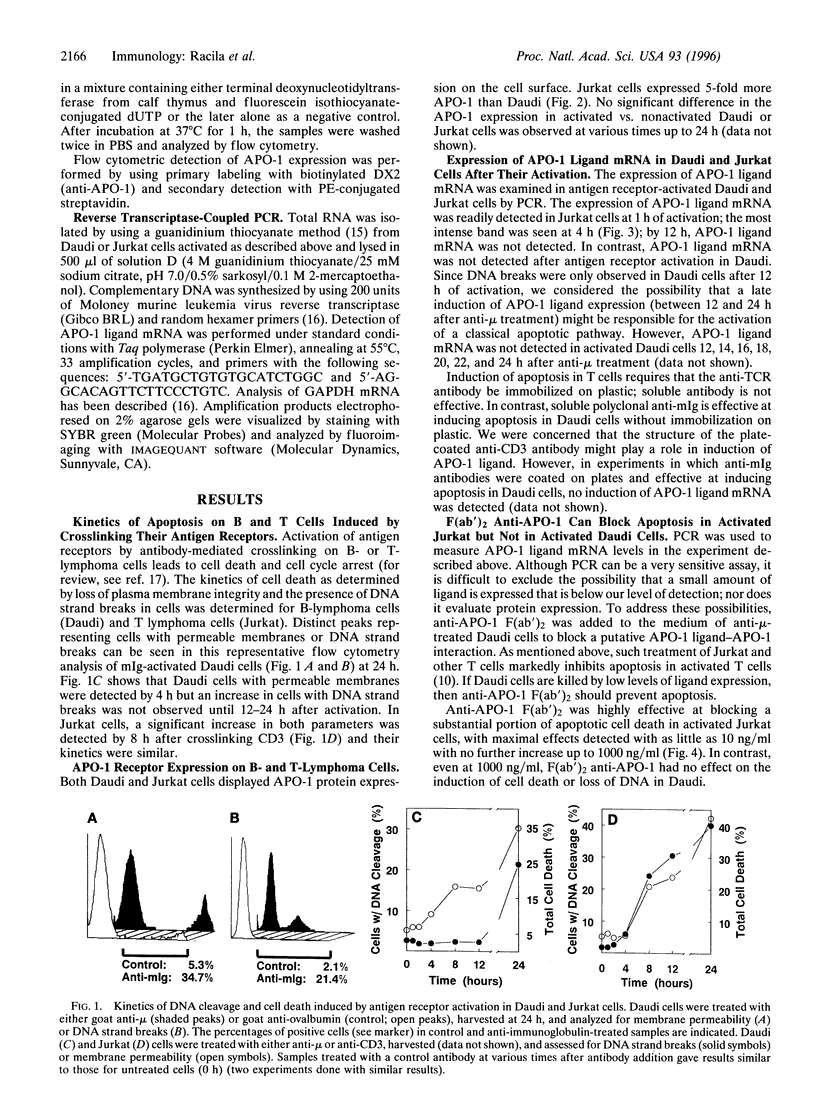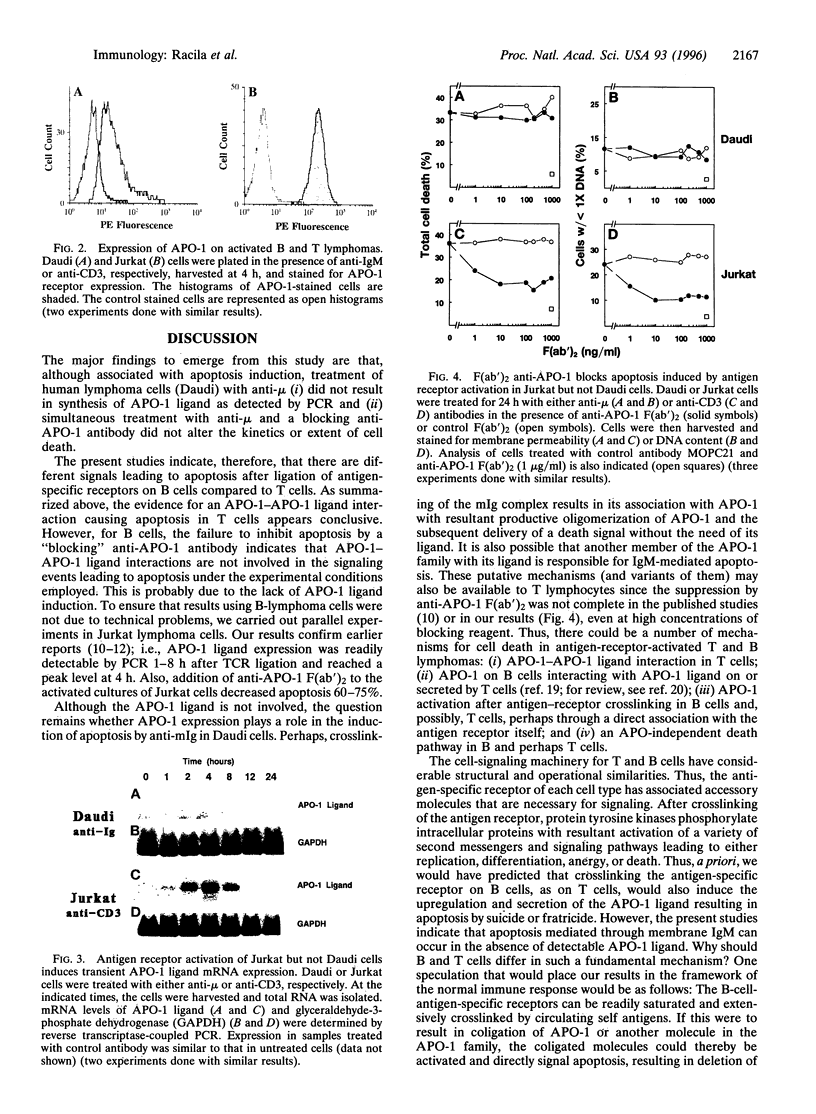Abstract
Signal transduction initiated by crosslinking of antigen-specific receptors on T- and B-lymphoma cells induces apoptosis. In T-lymphoma cells, such crosslinking results in upregulation of the APO-1 ligand, which then interacts with induced or constitutively expressed APO-1, thereby triggering apoptosis. Here we show that crosslinking the membrane immunoglobulin on human lymphoma cells (Daudi) (that constitutively express APO-1) does not induce synthesis of APO-1 ligand. Further, a noncytotoxic fragment of anti-APO-1 antibody that blocks T-cell-receptor-mediated apoptosis in T-lymphoma cells does not block anti-mu-induced apoptosis. Hence, in B-lymphoma cells, apoptosis induced by signaling via membrane IgM is not mediated by the APO-1 ligand.
Full text
PDF



Images in this article
Selected References
These references are in PubMed. This may not be the complete list of references from this article.
- Adachi M., Watanabe-Fukunaga R., Nagata S. Aberrant transcription caused by the insertion of an early transposable element in an intron of the Fas antigen gene of lpr mice. Proc Natl Acad Sci U S A. 1993 Mar 1;90(5):1756–1760. doi: 10.1073/pnas.90.5.1756. [DOI] [PMC free article] [PubMed] [Google Scholar]
- Berke G. The CTL's kiss of death. Cell. 1995 Apr 7;81(1):9–12. doi: 10.1016/0092-8674(95)90365-8. [DOI] [PubMed] [Google Scholar]
- Brunner T., Mogil R. J., LaFace D., Yoo N. J., Mahboubi A., Echeverri F., Martin S. J., Force W. R., Lynch D. H., Ware C. F. Cell-autonomous Fas (CD95)/Fas-ligand interaction mediates activation-induced apoptosis in T-cell hybridomas. Nature. 1995 Feb 2;373(6513):441–444. doi: 10.1038/373441a0. [DOI] [PubMed] [Google Scholar]
- Chomczynski P., Sacchi N. Single-step method of RNA isolation by acid guanidinium thiocyanate-phenol-chloroform extraction. Anal Biochem. 1987 Apr;162(1):156–159. doi: 10.1006/abio.1987.9999. [DOI] [PubMed] [Google Scholar]
- Chu J. L., Drappa J., Parnassa A., Elkon K. B. The defect in Fas mRNA expression in MRL/lpr mice is associated with insertion of the retrotransposon, ETn. J Exp Med. 1993 Aug 1;178(2):723–730. doi: 10.1084/jem.178.2.723. [DOI] [PMC free article] [PubMed] [Google Scholar]
- Dhein J., Daniel P. T., Trauth B. C., Oehm A., Möller P., Krammer P. H. Induction of apoptosis by monoclonal antibody anti-APO-1 class switch variants is dependent on cross-linking of APO-1 cell surface antigens. J Immunol. 1992 Nov 15;149(10):3166–3173. [PubMed] [Google Scholar]
- Dhein J., Walczak H., Bäumler C., Debatin K. M., Krammer P. H. Autocrine T-cell suicide mediated by APO-1/(Fas/CD95) Nature. 1995 Feb 2;373(6513):438–441. doi: 10.1038/373438a0. [DOI] [PubMed] [Google Scholar]
- Dyke R. J., McBride H., George A. J., Hamblin T. J., Stevenson F. K. Idiotypic vaccination against B-cell lymphoma leads to dormant tumour. Cell Immunol. 1991 Jan;132(1):70–83. doi: 10.1016/0008-8749(91)90007-x. [DOI] [PubMed] [Google Scholar]
- Funakoshi S., Longo D. L., Beckwith M., Conley D. K., Tsarfaty G., Tsarfaty I., Armitage R. J., Fanslow W. C., Spriggs M. K., Murphy W. J. Inhibition of human B-cell lymphoma growth by CD40 stimulation. Blood. 1994 May 15;83(10):2787–2794. [PubMed] [Google Scholar]
- Ghetie M. A., Picker L. J., Richardson J. A., Tucker K., Uhr J. W., Vitetta E. S. Anti-CD19 inhibits the growth of human B-cell tumor lines in vitro and of Daudi cells in SCID mice by inducing cell cycle arrest. Blood. 1994 Mar 1;83(5):1329–1336. [PubMed] [Google Scholar]
- Ju S. T., Cui H., Panka D. J., Ettinger R., Marshak-Rothstein A. Participation of target Fas protein in apoptosis pathway induced by CD4+ Th1 and CD8+ cytotoxic T cells. Proc Natl Acad Sci U S A. 1994 May 10;91(10):4185–4189. doi: 10.1073/pnas.91.10.4185. [DOI] [PMC free article] [PubMed] [Google Scholar]
- Ju S. T., Panka D. J., Cui H., Ettinger R., el-Khatib M., Sherr D. H., Stanger B. Z., Marshak-Rothstein A. Fas(CD95)/FasL interactions required for programmed cell death after T-cell activation. Nature. 1995 Feb 2;373(6513):444–448. doi: 10.1038/373444a0. [DOI] [PubMed] [Google Scholar]
- Nagata S. Fas and Fas ligand: a death factor and its receptor. Adv Immunol. 1994;57:129–144. doi: 10.1016/s0065-2776(08)60672-0. [DOI] [PubMed] [Google Scholar]
- Racila E., Scheuermann R. H., Picker L. J., Yefenof E., Tucker T., Chang W., Marches R., Street N. E., Vitetta E. S., Uhr J. W. Tumor dormancy and cell signaling. II. Antibody as an agonist in inducing dormancy of a B cell lymphoma in SCID mice. J Exp Med. 1995 Apr 1;181(4):1539–1550. doi: 10.1084/jem.181.4.1539. [DOI] [PMC free article] [PubMed] [Google Scholar]
- Scheuermann R. H., Bauer S. R. Polymerase chain reaction-based mRNA quantification using an internal standard: analysis of oncogene expression. Methods Enzymol. 1993;218:446–473. doi: 10.1016/0076-6879(93)18035-b. [DOI] [PubMed] [Google Scholar]
- Vitetta E. S., Uhr J. W. Monoclonal antibodies as agonists: an expanded role for their use in cancer therapy. Cancer Res. 1994 Oct 15;54(20):5301–5309. [PubMed] [Google Scholar]
- Vitetta E. S., Yuan D., Krolick K., Isakson P., Knapp M., Slavin S., Strober S. Characterization of the spontaneous murine B cell leukemia (BCL1). III. Evidence for monoclonality by using an anti-idiotype antibody. J Immunol. 1979 May;122(5):1649–1654. [PubMed] [Google Scholar]
- Wu J., Zhou T., He J., Mountz J. D. Autoimmune disease in mice due to integration of an endogenous retrovirus in an apoptosis gene. J Exp Med. 1993 Aug 1;178(2):461–468. doi: 10.1084/jem.178.2.461. [DOI] [PMC free article] [PubMed] [Google Scholar]
- Yefenof E., Picker L. J., Scheuermann R. H., Tucker T. F., Vitetta E. S., Uhr J. W. Cancer dormancy: isolation and characterization of dormant lymphoma cells. Proc Natl Acad Sci U S A. 1993 Mar 1;90(5):1829–1833. doi: 10.1073/pnas.90.5.1829. [DOI] [PMC free article] [PubMed] [Google Scholar]




